#Family: Tettigoniidae
Explore tagged Tumblr posts
Text
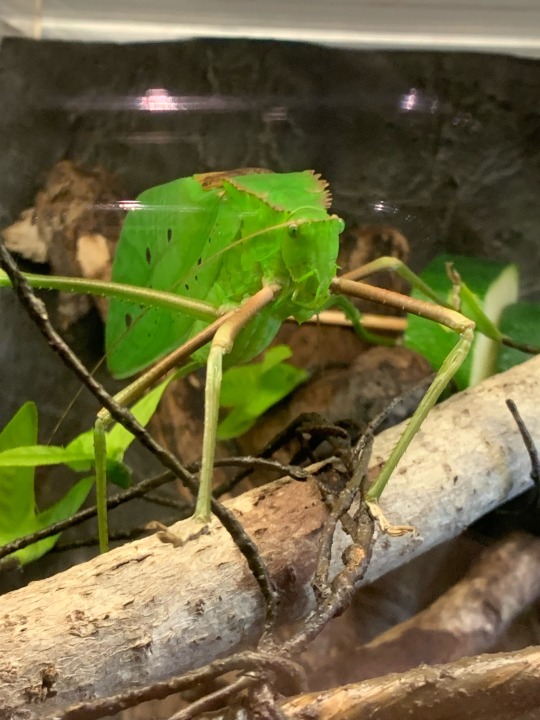
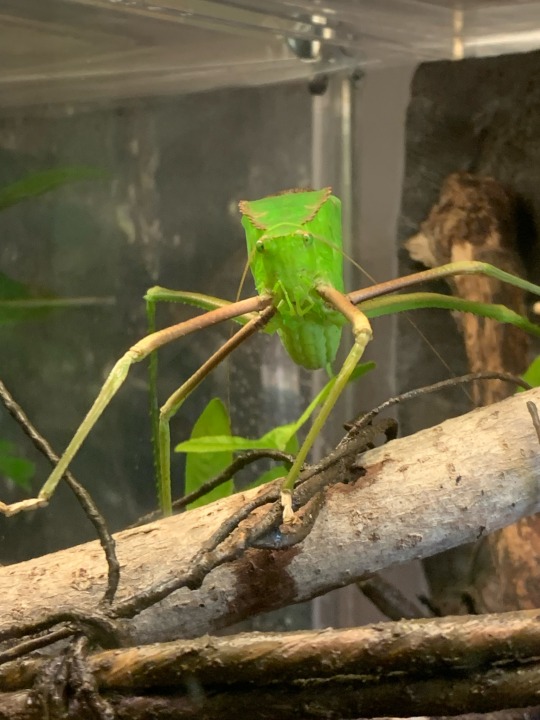
The Giant Katydid… what a chonker!
#Phylum: Arthropoda#Class: Insecta#Order: Orthoptera#Family: Tettigoniidae#Genus: Stilpnochlora#Stilpnochlora couloniana#giant katydids#katydids#insects
0 notes
Text

Lichen Katydid (Markia hystrix), family Tettigoniidae, found in Colombia and southern Panama
photograph by Nicholas Hess
#katydid#markia#orthoptera#tettigoniidae#insect#entomology#animals#nature#central america#south america
850 notes
·
View notes
Text
Thanks to everyone who suggested alternate answers on the last poll for me to use this time. @boss-the-goofball if you want someone to blame for this then talk to @bookwalmartav who exposed your real identity answering the previous poll.
93 notes
·
View notes
Text
youtube

Lichen Katydid (Markia hystrix, Family: Tettigoniidae), Costa Rica
11 notes
·
View notes
Note

sorry abt the blur, shaky hands, but is this a katydid? don't need a specific ID, just never seen one that wasn't a full adult. in oregon, hanging out on my roses
looks like a juvenile Phaneroptera nana, a non-native species of katydid!
52 notes
·
View notes
Text
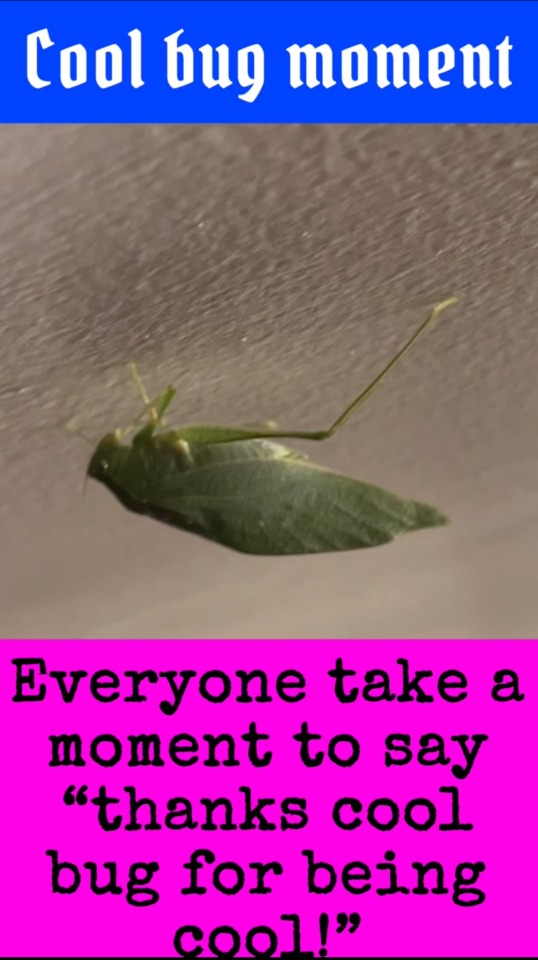
Everybody, I want to start Bug Time where I show pictures of bugs I find and put this kind of stuff around it.
This bug we see here is in the family Tettigoniidae. These fellas are called Katydids or Bush Crickets, they feed on other small insects and can live for about a year. They only get up to about 4-6 cm (2 inches) and may bite, but their jaws are too small to do anything to you.
Ok thanks, bug time over now.
#196#insects#bug facts#I’m actually not too knowledgeable about bugs and want to do this so I learn more of them#maybe you learn with me#bugs#nature#info#unsolicited information posting#special interest#it’s kinda a bug fixation#all you neurological mysteries out there get it
28 notes
·
View notes
Text

Found this gorgeous katydid.
The Copiphorini are a tribe of bush crickets or katydids in the family Tettigoniidae. Previously considered a subfamily (the Copiphorinae), they are now placed in the subfamily Conocephalinae. Like some other members of Conocephalinae, they are known as coneheads, grasshopper-like insects with an extended, cone-shaped projection on their heads that juts forward in front of the base of the antennae.
Neoconocephalus is a genus of katydids or bush crickets in the tribe Copiphorini, from the Americas. I believe it's one of those.
4 notes
·
View notes
Text
@mariemaniacmagic submitted: Found in Brasil, Rio Grande do Sul. Someone heard it making noises inside, so i got the pleasure of meeting this long guy! Around 4cm long, 7cm with the antennae. I think it got a little spooked and quieted down. My best guess is its a bug called "Esperança"(from portuguese, it means hope!), so it might be from the Tettigoniidae family.


It is definitely a katydid in Tettigoniidae! I’m thinking one of the common coneheads in the genus Neoconocephalus, but I’m not 100% on that.
66 notes
·
View notes
Text

Lichen Katydid (Markia hystrix), family Tettigoniidae, found in Colombia and southern Panama photograph by Nicholas Hess
0 notes
Text
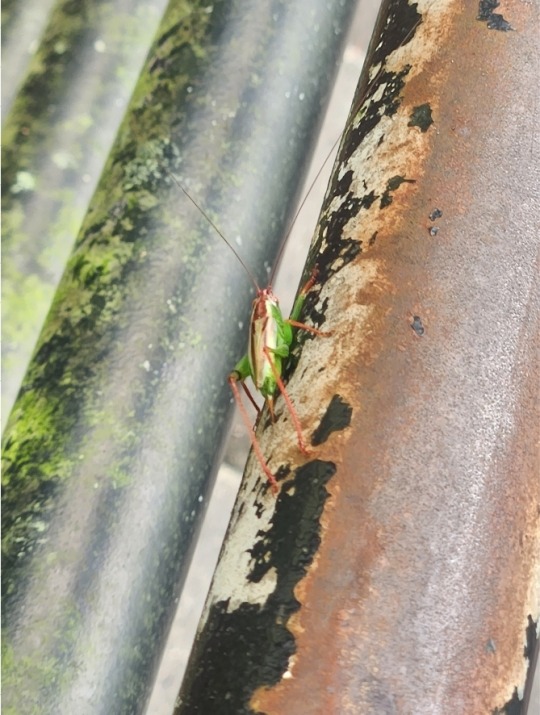
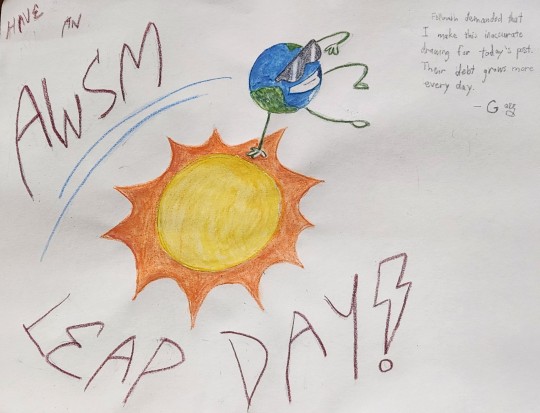
Salutations! Galen, here.
Since today's the day that makes leap years special, I thought I'd share some quick facts about an animal that leaps.
This is a picture of a kind of Meadow Katydid I found late last summer. These members of the Tettigoniidae family get their colloquial name from the sound they make: "Kay-tee-did(-did)", which can reach up to 20 KHz in volume. They are nocturnal, so their daytime roosting pose tricks predators into thinking they're leaves or dead, which explains how I found this one.
Like their Orthoptera Order relative the grasshopper, they have ears on their legs and can jump distances up to 20 times their body length.
Enjoy this extra day of the year.
1 note
·
View note
Text


Bronze Glandular Bush Cricket (Bradyporus dasypus), T - male, B - female, family Tettigoniidae, Bulgaria
photographs by Pat Cole
1K notes
·
View notes
Note
So Gentry, I know you only feed off the tears of readers but would you be willing to expand your dietary preferences to crickets? Asking for a friend.
Sorry, I switched to being Goofy Boss shortly after you sent this. However, regardless of who I am, everyone knows that Katydids are part of the Tettigoniidae family of insects and thus completely different from crickets. One would not have to be a katydid to know such common insect knowledge.
30 notes
·
View notes
Text
August 25th, 2022


Robust Coneheads (Neoconocephalus robustus)
Coneheads are a part of the Tettigoniidae family, more commonly referred to as katydids or bush crickets. As you may have guessed, they are named for the pinched shape of their heads. Conehead species can be easily identified by the shapes of their cones; the robust conehead, for example, has a head which is wider than it is long, setting it apart from its other cone-headed peers. The robust conehead is native to the eastern 2/3rds of the USA, but isolated populations can also be found in Central California.
Robust coneheads are the largest of the genus. It is thus fitting that these insects are also very loud; their song, which can be head anywhere from July to first frostq, has a peak frequency of 8 kHz and can be heard over at least 500 metres away, even closed moving car. Approaching these loud singers while they're preforming can be painful—quite literally. Their call has a volume of 116 decibels; for context, a revving motorcycle engine has a volume of 96 decibels, a music festival or concert is 100 decibels, and volumes of 120 decibels or more can cause permanent hearing damage. Like most singing insects, coneheads produce noise by rubbing a hind leg against their wings. Proportional to their impressive volume, this friction is so intense that a singing robust conehead's torso can be as much as 15⁰C above the ambient temperature!
Adult coneheads feed almost exclusively on grass seed, while larvae may feed on the flowers as well—conehead larvae may occasionally feed on corn, but they are not considered a major pest. These insects have a preference for humid habitats, found at the edges of wetlands, in moist upland fields and in the tall weeds at roadsides. Females have a long ovipositor, which they use to insert their eggs in the crowns of plants. Parasitism of males by tachnid fly maggots is very common—these flies find their hosts by following the sound of their song.
6 notes
·
View notes
Text

Pterochroza ocellata is an insect of the order orthoptera that appears among the so-called peacock hopes. The species has a wide distribution in the Amazon Forest, occurring in Brazil, Peru, Colombia and Ecuador. It was described by the naturalist and taxonomist Linnaeus in 1758. This is the only species known to the genus Pterochroza
These insects, members of the Tettigoniidae family, assume a typical defensive position when they feel threatened, raising their wings, spreading them out like a fan. On the lower wings, it has two spots that resemble eyes (called ocelos) that intimidate possible predators.
15 notes
·
View notes
Text


Stilpnochlora couloniana (Giant Katydid), Family Tettigoniidae. Found on a concrete wall near my college campus’s library on this day, February 7th, 2022.
2 notes
·
View notes
Photo





[7/24/20] Katydid (Nymph), Family Tettigoniidae.
just a little lad
#katydid#katydids#insect#insects#outdesign posts things#outdesign attempts to photo#insect catalog#with baby wing numbins
35 notes
·
View notes